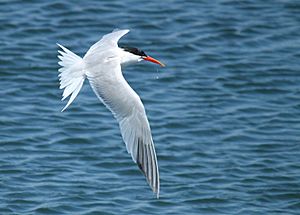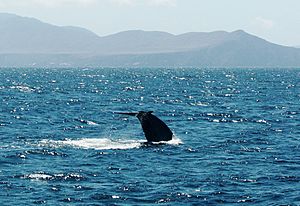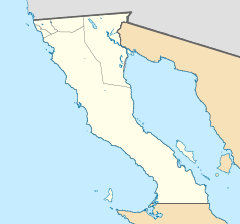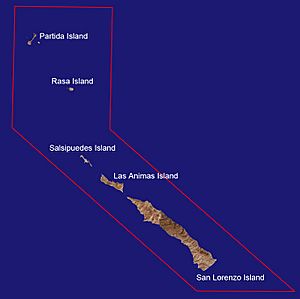San Lorenzo Marine Archipelago National Park facts for kids
San Lorenzo Marine Archipelago National Park is a special protected area in Mexico. It's located on San Lorenzo Island and other islands in the Gulf of California, also known as the Sea of Cortez. This area is super important for nature because it's home to many different plants and animals, especially marine life.
The Mexican government protects this area because it's a vital habitat for several endangered species. The park is part of the Mexicali Municipality in Baja California. San Lorenzo Island is found southeast of the city, separated by a channel called Salsipuedes.
Quick facts for kids Archipiélago de San Lorenzo National Park |
|
|---|---|
|
IUCN Category II (National Park)
|
|
| Location | Isla San Lorenzo, Gulf of California (Sea of Cortez), Mexicali Municipality, Baja California, Mexico |
| Nearest city | San Quintín |
| Area | 504.42 km2; 124,640 acres (50,442 ha) |
| Established | April 25, 2005 |
| Governing body | Secretariat of the Environment and Natural Resources |


Contents
Why the Park Was Created
The San Lorenzo Marine Archipelago National Park was officially created on April 25, 2005. It was made a national park to protect the amazing and delicate ecosystem of the San Lorenzo Archipelago. This area has a huge variety of marine life, including many species that are threatened or endangered.
Because of this, the Mexican government decided it was very important to protect this special place. The park is also used for fishing, cultural activities, and fun recreation.
Exploring the Park's Geography
The park includes the islands of San Lorenzo, Las Animas, Salsipuedes, Rasa, and Partida. It also covers the ocean waters around these islands. In total, the park is about 50,442 hectares, which is a very large area. Most of the park is made up of ocean.
The islands themselves are rugged and have uneven coastlines. They have many sea cliffs that have been shaped by the ocean. The land goes from sea level up to 485 meters high. The tallest parts are on San Lorenzo Island, towards its southern end. The waters around the islands are deep, cold, and full of nutrients. This makes them a perfect home for lots of marine animals.
Weather and Climate in the Park
The climate in the San Lorenzo Archipelago is like a dry desert. It gets very little rain, only about 2.54 inches each year. The average temperature is around 75°F (24°C). There's a lot of sunshine and constant winds, which makes water evaporate quickly.
Summers are very hot, with temperatures reaching between 95°F (35°C) and 104°F (40°C) in July and August. Winters are warm, with average low temperatures around 52°F (11°C) in January and February. Winds also affect the ocean. In winter, winds from the northwest bring nutrient-rich waters from the Pacific Ocean into the Gulf of California. In summer, winds from the south change the ocean currents.
Amazing Plants and Animals
San Lorenzo Marine Archipelago National Park has unique ecosystems and habitats. These support a great food chain, which is important for marine animals, birds, and even people living nearby. The rich waters of the Gulf of California are home to over 800 types of fish and 2,000 kinds of invertebrates (animals without backbones).
Island Plants
The islands might look dry because there isn't much fresh water. Only a few desert shrubs and cactus plants can grow here. However, the ocean has many different types of algae. Algae are like underwater plants and they provide a perfect home for small marine species.
Marine Animals and Their Reproduction
The park is home to many amazing animals, including several endangered species. These include the blue whale, humpback whale, killer whale, and sperm whale. You might also see different types of sea turtles like the green turtle, hawksbill turtle, and olive ridley turtle. Another important endangered fish found here is the totoaba.
Many commercially important fish also live in these waters. You can find swordfish, hake fish, and Risso's dolphin.
Important Bird Nesting Sites
Rasa Island is a very important place for birds to build their nests and lay eggs. Many birds come here, including the Heermann's gull, elegant tern, American oystercatcher, Craveri's murrelet, and brown pelican. It's estimated that about 260,000 Heermann's gulls and 200,000 elegant terns nest here. This is about 95% of the total world population for these species!
Salsipuedes Island, Las Animas Island, and San Lorenzo Island are also important places for brown pelicans to reproduce in the Gulf of California. Between 6,000 and 18,000 brown pelican pairs are estimated to nest on these three islands.
The islands also support many other bird species. Some birds live here all the time, while others migrate through. They are all attracted to the rich marine ecosystem. Some birds you might see include the Cooper's hawk, golden eagle, peregrine falcon, different types of pigeons and doves (Columbidae), the magnificent frigatebird, and the Nazca booby.
See also
 In Spanish: Parque nacional marino Archipiélago de San Lorenzo para niños
In Spanish: Parque nacional marino Archipiélago de San Lorenzo para niños





